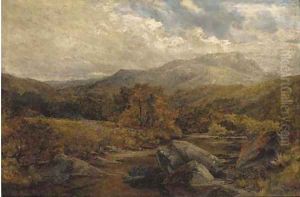James Callowhill Paintings
James Callowhill was a British artist born in 1838, whose life and career spanned the Victorian era, a period known for its dramatic changes and developments in arts and culture. While not as widely recognized as some of his contemporaries, Callowhill made significant contributions to the art world, particularly in the realms of painting and pottery decoration. His work reflects the broader artistic movements of his time, including the influence of Romanticism and the early inklings of Modernism, blending traditional techniques with emerging styles.
Callowhill's artistic journey began in the United Kingdom, where he honed his skills in painting and developed an interest in ceramic art. This was a time when the British Empire was at its zenith, and the arts flourished with patronage from the upper classes and the burgeoning middle class. Callowhill capitalized on this environment, merging his painting skills with the craft of pottery, a combination that was becoming increasingly popular in the decorative arts of the period.
Throughout his career, James Callowhill became particularly well-regarded for his work with ceramics. He joined the prestigious Royal Worcester Porcelain Company, where he applied his artistic talents to designing and decorating fine bone china. His designs often featured landscapes, floral patterns, and occasionally scenes from everyday life, characterized by their meticulous detail and vibrant colors. These pieces were highly valued for their artistic merit and craftsmanship, contributing to the reputation of Royal Worcester as a leader in porcelain artistry.
Callowhill's work is notable for its reflection of Victorian tastes and sensibilities, yet he also pushed the boundaries of ceramic decoration. He experimented with various techniques, including the use of different glazes and the incorporation of Japanese and Chinese motifs, which were fashionable among the British elite at the time. This blend of traditional British subjects with Asian influences exemplifies the eclectic nature of Victorian art and design, marking Callowhill as an innovator in his field.
James Callowhill's career was not just limited to his contributions to ceramics. He also remained active in the painting community, contributing works to exhibitions and maintaining ties with other artists of his era. His paintings, like his ceramic works, often depicted natural scenes and landscapes, executed with a keen eye for detail and a deep appreciation for the beauty of the natural world.
Callowhill passed away in 1917, leaving behind a legacy that, while perhaps not as widely celebrated as some of his peers, made a lasting impact on the world of Victorian art, particularly in the realm of decorative ceramics. Today, his works can be found in museums and private collections, admired for their beauty and craftsmanship. James Callowhill's life and career exemplify the rich tapestry of the Victorian art scene, blending tradition with innovation and contributing to the enduring legacy of British art.
